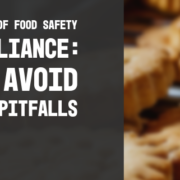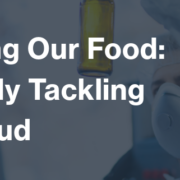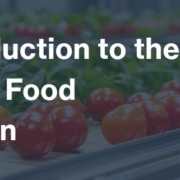The Challenges of Digital Transformation in Food Safety: How we Guarantee Success
70% of digital transformation projects fail due to common pitfalls that are easily avoidable.
When the odds of achieving success are not in your favour, and not succeeding is not an option for your business goals – this can be extremely daunting when considering overhauling your Quality Management System and uncoupling it from Sharepoint, Excel, papers and binders.
Over the last 10 years my team and I in Professional Services have worked with brands of all sizes and seen every mistake that can be made.
Whether you’re a global Enterprise or a single site manufacturer who is just recently certified and overwhelmed with the burden of compliance, a digital transformation journey can be difficult.
You know what the problem is, you know what you need and want to do to solve it – and yet, you just can’t get there.
So why is it when you first demo a software, map your requirements, assemble your team, review everything comprehensively, select your vendor, and start implementing – it’s often the same story?
The simple answer is it is never just simply one reason, it’s not that you chose the wrong software, or your requirements were vague, or the team was inappropriate, or that you missed a redline in review, but it’s a myriad tapestry with many things to watch out for – and if this is your first time doing it, you don’t know what to look for because you don’t know what you don’t know.
What is the answer?
With so many densely layered problems solving it can seem impossible, but we have a tried and tested approach that cuts this gordion knot and makes it possible.
We call it Professional Services.
This is not simply a team, but an entire division of our company and is mandatory for everyone who is interested in deploying any software solution from Safefood 360°.
We know that the platform is excellent at best, and comparable to the rest of the market at worse, but if you’re in the market for a new car and someone puts you in the cockpit of a G550, Cessna or Bombardier Global 6000, you just aren’t going to know what to do – despite your very lavish investment.
So, similar to how a pilot needs a plane and a navigation system – we also provide both, with our PS team appointed to you for every step of your project and absolutely dedicated to achieving your stated business goals.
Put simply, this team exists solely to do the heavy lifting of your project, make your life easier, and provide a seamless experience as you build your Safefood platform.
How do we do it?
The Professional Services team leads and manages all project elements from the moment you sign your contract to after your leadership sign off that they are satisfied that all scoped deliverables have been achieved.
We do this through a detailed and actionable project plan which covers:
- Module Prioritisation
- Data Collection
- Data Validation
- Program Set Up
- Full User Training
- Hypercare
The PS team diligently ensures that all programs and documentation are established efficiently, in alignment with the business’ goals and objectives, and that all your users are trained to a high standard to be fully self-sufficient in using the platform.
Every member of the PS team has extensive experience with major retailer standards, including Global Food Safety Initiative (GFSI) standards such as BRCGS, SQF, and FSSC, as well as global legislation, including FSAI (Ireland), FSA (UK), FDA (USA), USDA (USA) and EFSA (EU).
What does an implementation project look like?
This will vary depending on the size and structure of your company, as well as the nature of the project itself.
The below provides an overview of what each of these may look like, but once you start speaking to your sales agent during your due-diligence process, we’ll be able to more accurately advise.
Once the project is formally scoped and approved, a kick-off meeting is conducted with a dedicated Project Manager and myself (Vice President of Professional Services) to define project priorities and set expectations for the onboarding process.
This is designed to ensure you get maximum stakeholder commitment from our side and that we are fully committed to achieving your business goals.
Based on the number of sites and the articulated scope, various types of implementations are possible:
- Number of Sites:
- Single Site: Implementation is limited to one site. No site structure is required for these projects.
- Multi-site: Implementation encompass multiple locations, which can be within the same country or globally.
- Scope:
- Food Safety Management
- Supplier Quality Management
- Both Food Safety and Supplier Quality Management
Based on your project implementation parameters, the most suitable onboarding approach will be selected from the following options:
- Vertical Approach
- Horizontal Approach
- Hybrid Approach
Vertical Approach
The vertical approach is most effective when one site has already established best practices and procedures, and the client wishes to replicate this implementation across all other sites. The process begins with the implementation of all modules at one site which is designated as the pilot site.
Horizontal Approach
The horizontal approach is particularly well-suited for scenarios where all sites maintain a consistent level of best practices and established procedures but are not standardised.
It is especially advantageous when the customer aims to achieve process standardisation concurrent with SF360 implementation.
It can support management scenarios where one project manager can oversee each site individually or an overarching project manager can coordinate data gathering across all sites simultaneously.
Hybrid Approach
The hybrid approach merges elements of both the vertical and horizontal methods.
The implementation proceeds at one site exclusively, which is defined as the pilot, or simultaneously across all sites, focusing on modules such as HACCP, Cleaning, Recall and others.
Regardless of the approach we use, we also incorporate a hybrid project methodology combining Waterfall and Agile.
Some workflows will need to follow a prescribed path, while others can be done simultaneously.
This approach can be highly effective for projects with both predictable and adaptable components.
Implementation Stages
Once the type of implementation project outlined above has been defined and agreed upon, the implementation process is initiated.
The implementation process is divided into nine stages, which are as follows:
- Data Intake
- Clean-up and standardisation
- Upload
- Validation
- Training
- Go Live
- Go Live Hyper Care
- Admin Training
- Project Sign Off
-
Data Intake
This stage involves collecting specific data and documents such as: Master Data (e.g., documents, procedures, specifications) and other controlled documents, system records, programs and plans, inspections, checklists, and any other documents used in the current food safety management process.
-
Data Clean-Up & Standardisation
This is a necessary step in data projects of a sensitive or wide-ranging nature.
Data Clean-Up involves analysing the provided data and determining if there are any necessary adjustments needed in order to meet the standards for upload into SF360.
This is done with your agreement and will be validated to ensure that nothing is being destroyed.
-
Upload
Data upload involves transferring your data to the platform.
The upload process is conducted in stages, module-by-module, based on your priorities which we establish during the project’s kick-off meeting.
-
Data Validation
During data validation, the customer has the opportunity to log in, review and validate the data that has been uploaded to the SF360 platform.
At this point you will be provided with several links to sample records which will allow you to test the records in safe environment.
If there are any issues at this stage, we will investigate together thoroughly and revisit the first three steps to redress and ensure that optimum data capture, workflows and processes are being deployed before any further steps are taken.
-
Training
Training sessions are supplemented by a library of system resources, including webinars and an in-depth user guide.
You might also prefer to have live training on specific elements of the software.
If you do this, we will complete 1-to-1 or 1-to-many training records specific to your instance of the platform through scenario based training or interactive quizzes specific to your work flows.
These sessions can also be recorded creating a personalised library of instructional videos that you can refer back to at any time for new joiners or simple as a refresher for staff if its needed.
-
Go Live
The Go Live phase varies depending on the project type.
For a Supplier Quality Management project, Go Live mainly focuses on supplier and/or material assessments, including pre-assessments, full assessments, supplier corrective actions and supplier audits.
For other projects, such as Food Safety Management, Go Live focuses only on the modules that have been implemented.
Sometimes, at this time, your team may be more comfortable and wish to increase the scope of the project.
That’s fine if it happens, simply speak to us and we’ll advise you of what that might look like to achieve, and the plan can be modified if needed.
-
Go Live Hyper Care
We don’t simply let go of your hand once the project is “complete” and tell you we’ll be in touch next year when your bill is due.
During this period, your teams are provided with additional support as you continue to use the system.
During this phase you may address any unexpected issues that arise during or immediately after the Go Live phase.
-
Admin Training
Admin training focuses on managing and updating Master Data within the system.
These sessions empower administrators to operate autonomously and effectively within the platform.
These are provided concurrently with the above steps or can be done towards the end if that’s cleaner.
Again, similar to general training in step 5, these sessions can be bespoke to your iteration of the platform and recorded so you always have a reference point.
-
Project Sign Off
Project Sign Off is the final stage of implementation.
After all modules are built, validated, and the training is completed, Q&A sessions or meetings are taking place to address any remaining questions or concerns.
Once your project leaders or Executive team are satisfied, a final close-out meeting takes place where we review everything to ensure nothing is missed, provide any final suggestions on your future use, and leave the door open for future collaboration should you ever need us again.
Conclusion
We acknowledge that every company offers support and configuration services, but our feedback from our customers is that ours is incomparable to competitor offerings.
At every step of the way we promise to deliver you a collaborative and well-structured approach that reinforces the trust you have placed in us by choosing us as your vendor.
This is what enables us to maintain our position as a global leader in Food Safety and Supplier Quality Management software and why we are pleased to sit alongside other LGC brands who have delivered assurance, quality and trust to food manufacturers, importers and governments for more than 180 years.
We also accept that life is messy and that projects are ultimately fluid creations.
This is why we our PS team remain available beyond the initial setup and encompasses the entire lifecycle of your software usage, including ongoing training and development to ensure you maximise the software’s potential.
At Safefood 360°, our commitment to excellence and comprehensive support guarantees that every integration process is smooth, efficient and successful.
Our expertise and dedication help every customer meet and exceed their food safety and supplier quality management goals.
If you are still unsure, send us a message and we’ll put you in touch with one of our customers who are similar to your own production so you can hear from them directly, or simply watch the below to see what success looks like.












Leave a Reply
Want to join the discussion?Feel free to contribute!